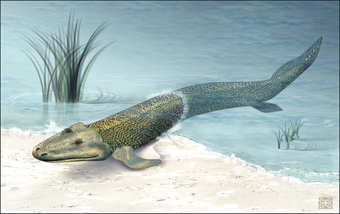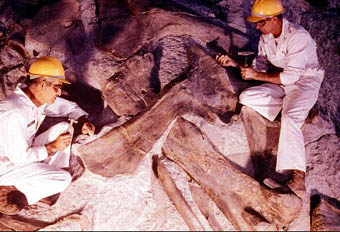Click on image for full size
Courtesy of Zina Deretsky, National Science Foundation
Details of Evolutionary Transition from Fish to Land Animals Revealed
News story originally written on October 15, 2008
Scientists have gotten inside the head of a 375-million-year-old fossil animal.
They have been studying the inside of the head skeleton of Tiktaalik roseae, a fossil animal that was important link in the transition from fish to animals that walked on land.
Tiktaalik roseae (tik-TAHL-ik RO-zay) was a large aquatic predator with a flattened head and body. It was somewhat similar to the earliest four-footed animals that lived on land, but it also had features of fish, like scales and fin rays. Evidence suggests that the creature lived on the bottom in shallow water, and perhaps out of the water for short periods too.
The transition from life in the water to on land involved complex changes. Animals evolved from having fins to having limbs that can walk on land. And their heads changed too.
It took more than a year for scientists to get the delicate fossil head skeleton out of the sedimentary rock in which it was preserved. They found that the head had features that are usually associated with land animals like a flat skull and a long snout. The scientists suspect that these features helped Tiktaalik roseae survive in shallow water.
"Fish in deep water move and feed in three-dimensional space, and can easily orient their bodies in the direction of their prey," said biologist Farish Jenkins, Jr. "A mobile neck is advantageous in settings where the body is relatively fixed, as is the case in shallow water and on land."















